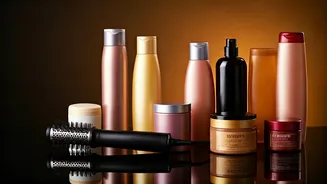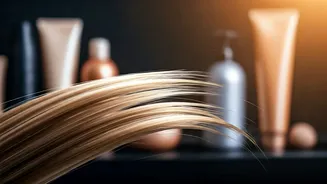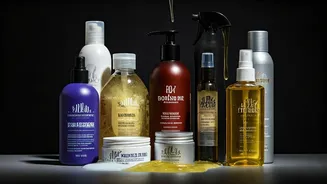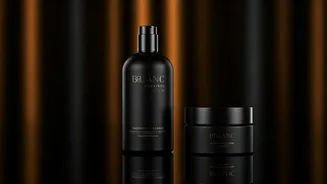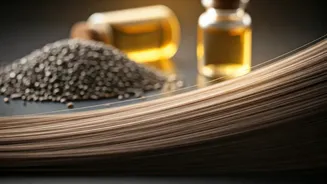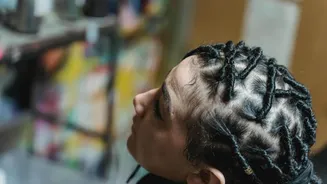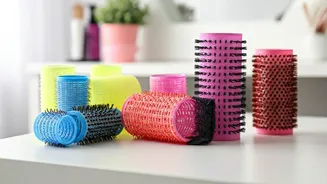Hair's Intricate Structure
Understanding the fundamental structure of hair is the first step towards effective care. Hair is composed of three primary layers: the cuticle, cortex,
and medulla. The cuticle, the outermost layer, acts as a protective shield, made up of overlapping scales that determine shine and smoothness. The cortex, the thickest layer, houses the protein keratin, which provides strength and elasticity. This layer also contains melanin, responsible for hair color. The medulla, the innermost layer, is not always present but contributes to the hair's overall structure. Factors such as genetics, nutrition, and environmental influences impact hair's structure and overall health. Furthermore, knowing this structure helps one to choose the right products that are designed to support and enhance each of these layers, leading to improved hair health and appearance.
Effective Cleansing Techniques
Cleansing is a cornerstone of hair care, removing dirt, oil, and product buildup. Choosing the right shampoo is crucial, considering your hair type and concerns. For oily hair, clarifying shampoos can remove excess oil and buildup, while dry hair benefits from moisturizing shampoos with hydrating ingredients. The frequency of washing varies; however, washing too frequently can strip natural oils, leading to dryness and damage. Always focus shampoo on the scalp, gently massaging it to lift dirt and debris. Rinse thoroughly to ensure all product residue is removed. Consider the water temperature as well; warm water opens the hair cuticle, aiding in thorough cleansing, while cold water seals it, boosting shine and smoothness. Incorporating these cleansing techniques into your routine can lead to healthier, more manageable hair.
Nourishing Conditioning Methods
Conditioning is crucial for maintaining hair's moisture balance, flexibility, and overall health. Conditioners work by smoothing the cuticle and restoring the hair's natural oils. There are numerous types of conditioners, including daily conditioners, deep conditioners, and leave-in conditioners. Daily conditioners should be used after every shampoo, providing essential moisture and detangling the hair. Deep conditioners offer intense hydration, and are ideal for dry or damaged hair; these are applied for longer durations, usually 20-30 minutes, or overnight for optimal results. Leave-in conditioners can be applied to damp hair after washing, providing all-day moisture and protection from environmental stressors. When applying conditioner, focus on the mid-lengths and ends of your hair, where it is most prone to damage. Using the correct conditioning methods will help the hair become stronger, softer, and more resilient.
Safe Styling Practices
Styling can enhance hair appearance, but it's essential to practice safe methods to avoid damage. Heat styling tools, such as hair dryers, straighteners, and curling irons, can inflict significant damage if not used cautiously. Always use heat protectant products to create a barrier between the hair and heat. Minimize heat exposure by air-drying your hair whenever possible. When using heat tools, use the lowest effective temperature setting and limit the duration of use. Protective hairstyles, such as braids, buns, and low ponytails, can reduce mechanical stress on the hair. Avoid tight hairstyles that pull on the roots, causing breakage. Choose hair products carefully, avoiding those with harsh chemicals that can dry out or damage your hair. Regular trimming helps eliminate split ends, which prevent further damage and supports overall hair health.
Addressing Common Concerns
Various hair concerns necessitate tailored care strategies. For instance, dry hair lacks moisture, requiring moisturizing shampoos and conditioners, plus regular deep conditioning treatments. Oily hair benefits from clarifying shampoos and lightweight conditioners, coupled with the avoidance of excessive product usage. Dealing with dandruff requires the use of medicated shampoos containing ingredients like ketoconazole or selenium sulfide. Hair loss can be addressed through lifestyle changes such as stress reduction, a balanced diet, and the use of hair growth-promoting products like minoxidil. In all of these cases, it is crucial to consult a dermatologist for personalized guidance. Implementing these specialized care methods in a systematic way can effectively address common hair issues, leading to improved health and appearance.
